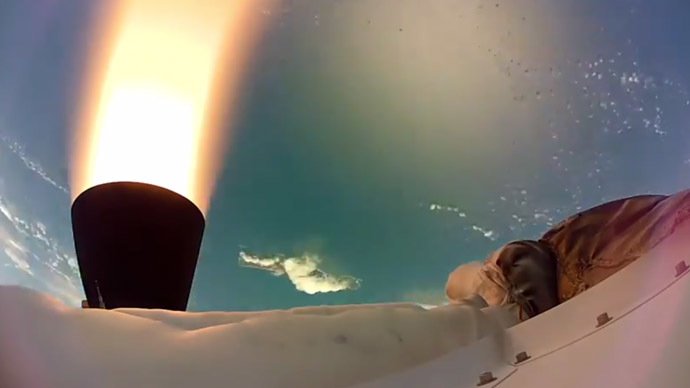The US space agency released a spectacular video detailing the testing of an interplanetary landing system, which is designed to place more massive payloads on the surface of Mars, as it hurtled toward Earth.
In the cosmic quest to explore the surface of Mars, NASA is attempting to devise technologies that will allow it to deliver heavy payloads to the mysterious red planet. In June, NASA engineers, with the help of a massive balloon, lifted the 7,000-pound (3,175 kg) saucer-shaped test vehicle to an altitude of 190,000 feet (58 kilometers) before it was released.

The strenuous trial, which tested the so-called Low-Density
Supersonic Decelerator (LDSD), was designed to create conditions
similar to that of a Mars landing.
At this point, with rockets firing to keep the vehicle
stabilized, video from NASA’s Jet Propulsion Laboratory showed
the ‘flying saucer’ traveling at a speed of Mach 4.3 – or more
than four times the speed of sound. Engineers then released an
inflatable, life-preserver shaped device around the perimeter of
the vehicle, officially known as a Supersonic Inflatable
Aerodynamic Decelerator, or SIAD, which slowed the craft to Mach
2.
However, while the inflatable device proved tough enough to
endure the rigors of such intense force, the 100-foot-wide
parachute proved less successful, and nearly disintegrated as it
attempted to slow the bulky, fast moving object on its descent
toward Earth.
"The idea of taking 200 pounds of Kevlar and nylon and
deploying it at 2,500 mph, 200 pounds that inflated would be the
size of a small warehouse, is certainly a challenging endeavor.
There's a lot of physics with this problem that we're now gaining
new insights into that we've never had before," said Ian
Clark, principal investigator at NASA's Jet Propulsion
Laboratory, as quoted by AP.
"We're going to take all of that knowledge, and feed it
toward our flights next year."
According to the NASA website, LDSD “seeks to use
atmospheric drag as a solution, saving rocket engines and fuel
for final maneuvers and landing procedures.”
Despite the setbacks, NASA officials were clearly pleased with
the video data sent back from the vehicle.
Project manager Mark Adler said that the videos will help his
team as they continue to study how to improve the LDSD’s
performance for a mission to Mars.
“If a picture is worth a thousand words, then a video is
worth about a million,” Adler said, as quoted by the Los
Angeles Times.
The government space agency then hinted of more ambitious plans
for the red planet in the future, which will include crews. That
will require new landing equipment to replace the basic Viking
parachute system, which has been used since 1976, when NASA
placed two vehicles on Mars.
“The heavier planetary landers of tomorrow…will require much
larger drag devices than any now in use to slow them down - and
those next-generation drag devices will need to be deployed at
higher supersonic speeds to safely land vehicle, crew and
cargo.”
NASA, which will conduct its second round of tests on the ‘Flying
Saucer’ next summer, just celebrated the two-year anniversary of
placing its most sophisticated rover, Curiosity, on the surface
of Mars, which was also carried out using basic parachute landing
gear.
The distance between Earth and Mars constantly changes due to the
difference of their orbits. In 2003, Earth and Mars were only 56
million kilometers (35.7 million miles) apart, the closest they’d
been in 50,000 years. On July 27, 2018 the red planet will be
57.6 million km (35.8 million miles) from Earth.

